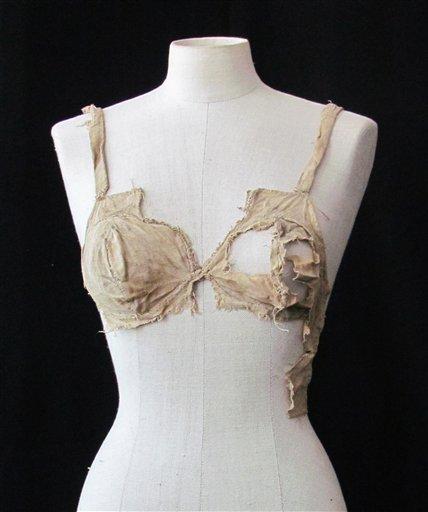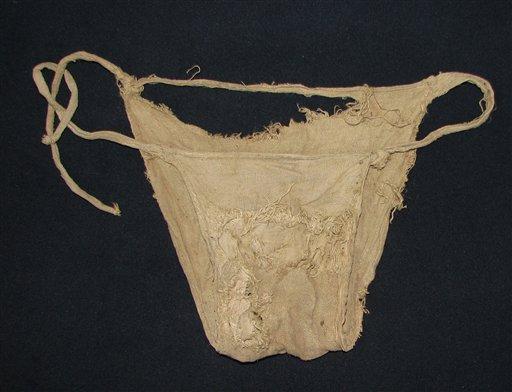600-year-old linen bras found in Austrian castle
George Jahn
Source - http://phys.org/news/2012-07-year-old-linen-bras-austrian-castle.html

This undated picture publicly provided by the Archeological Institute of the University of Innsbruck, shows a medieval bra. The bra is commonly thought to be little more than 100 years old as corseted women abandoned rigid fashions and opted for the more natural look. But that timeline is about to be revised with the discovery of four brassieres from the Middle Ages in a debris-filled vault of an Austrian castle. The find, formally announced Wednesday July 18, 2012 by the University of Innsbruck, is being described by historical fashion experts as revolutionary because it indicates that the bra was already worn around 600 years ago before being abandoned for the stiff stays dictated by the form-hugging clothing that become the mode for centuries. (AP Photo/University Innsbruck Archeological Institute)
(AP) — A revolutionary discovery is rewriting the history of underwear: Some 600 years ago, women wore bras
The University of Innsbruck said Wednesday that archeologists found four linen bras dating from the Middle Ages in an Austrian castle. Fashion experts describe the find as surprising because the bra had commonly been thought to be only little more than 100 years old as women abandoned the tight corset. Instead, it appears the bra came first, followed by the corset, followed by the reinvented bra. One specimen in particular "looks exactly like a (modern) brassiere," says Hilary Davidson, fashion curator for the London Museum. "These are amazing finds." Although the linen garments were unearthed in 2008, they did not make news until now says Beatrix Nutz, the archaeologist responsible for the discovery. Researching the items and carbon dating them to make sure they were genuine took some time. She delivered a lecture on them last year but the information stayed within academic circles until a recent article in the BBC History Magazine.

This undated picture publicly provided by the Archeological Institute of the University of Innsbruck, shows medieval underwear. The find, formally announced Wednesday by the University of Innsbruck, is being described by historical fashion experts as revolutionary because it indicates that the bra was already worn around 600 years ago before being abandoned for the stiff stays dictated by the form-hugging clothing that become the mode for centuries. Also found at Lemberg Castle in Tyrol was a linen undergarment that looks very much like a pair of panties. (AP Photo/University Innsbruck Archeological Institute)
"We didn't believe it ourselves," she said in a telephone call from the Tyrolean city of Innsbruck. "From what we knew, there was no such thing as bra-like garments in the 15th century." The university said the four bras were among more than 2,700 textile fragments — some linen, others linen combined with cotton — that were found intermixed with dirt, wood, straw and pieces of leather. "Four linen textiles resemble modern-time bras" with distinct cups and one in particular looks like today's version, it said, with "two broad shoulder straps and a possible back strap, not preserved but indicated by partially torn edges of the cups onto which it was attached." And the lingerie was not only functional. The bras were intricately decorated with lace and other ornamentation, the statement said, suggesting they were also meant to please a suitor. While paintings of the era show outerwear, they do not reveal what women wore beneath. Davidson, the fashion curator, described the finds as "kind of a missing link" in the history of women's underwear. Women started experimenting with bra-like garments in the late 1800s and the first modern brassiere was patented in the early 19th century. It is thought to have been invented by New York socialite Mary Phelps Jacob, who was unhappy with the look of her gown over a stiff corset. Also found at Lemberg Castle in Tyrol was a linen undergarment that looks very much like a pair of panties. But Nutz said it is men's underwear — women did not wear anything under their flowing skirts back then. "Underpants were considered a symbol of male dominance and power," she said. Medieval drawings often show a man and a woman fighting for a pair of underpants in a symbolic battle to see who "wears the trousers" in the family.
Copyright 2012 The Associated Press
Des soutiens-gorge du Moyen Age retrouvés en Autriche
Source - http://www.slate.fr/lien/59535/soutien-gorge-moyen-age
Si vous pensiez que le Moyen Age était une époque sans raffinement, il va falloir revoir vos clichés. Une équipe de chercheurs autrichiens a retrouvé des soutiens-gorge vieux de 500 ans, rapporte le BBC History Magazine.
Les chercheurs ont découvert quatre soutiens-gorge dans le château de Lengberg dans le Tyrol. Les sous-vêtements, faits de lin, étaient dans une cave située dans le sud du bâtiment. Jusqu'à présent, les historiens pensaient que les soutiens-gorge étaient une invention moderne datant des années 1900. Avant cette date, les femmes portaient généralement des corsets.
D'après les chercheurs, les sous-vêtements découverts sont relativement similaires aux soutiens-gorge contemporains. L'un d'entre eux (le mieux conservé) ressemble aux soutiens-gorge des années 1950, avec une partie supplémentaire qui descend le long du torse. Un deuxième possède deux bretelles.
Les vêtements en lin ont en fait été découverts en 2008, mais ceux-ci n'ont été rendu publics que récemment par le biais d'un article dans le BBC History Magazine. D'après Beatrix Nutz, l'archéologue qui a conduit les recherches, les sous-vêtements faisaient partie d'une collection de près de 2.700 pièces. Celle-ci n'en revient toujours pas de sa découverte:
«Nous n'arrivions nous-même pas à y croire. De ce que nous savions alors, il n'existait pas de vêtements de types soutiens-gorges au XVe siècle.»
Les historiens attribuaient jusqu'à présent l'invention du soutien-gorge soit à une Français nommée Herminie Cadolle dans les dernières années du XVIIIe siècle ou bien à l'Américaine Mary Phelps Jacob, dépositaire du brevet depuis 1914.
Comme l'explique Wired, les historiens avaient déjà repéré quelques références à des habits ressemblants à des soutiens-gorge dans des textes médiévaux, mais jusqu'à présent, il n'y avait aucune preuve physique de l'existence de ces sous-vêtements.